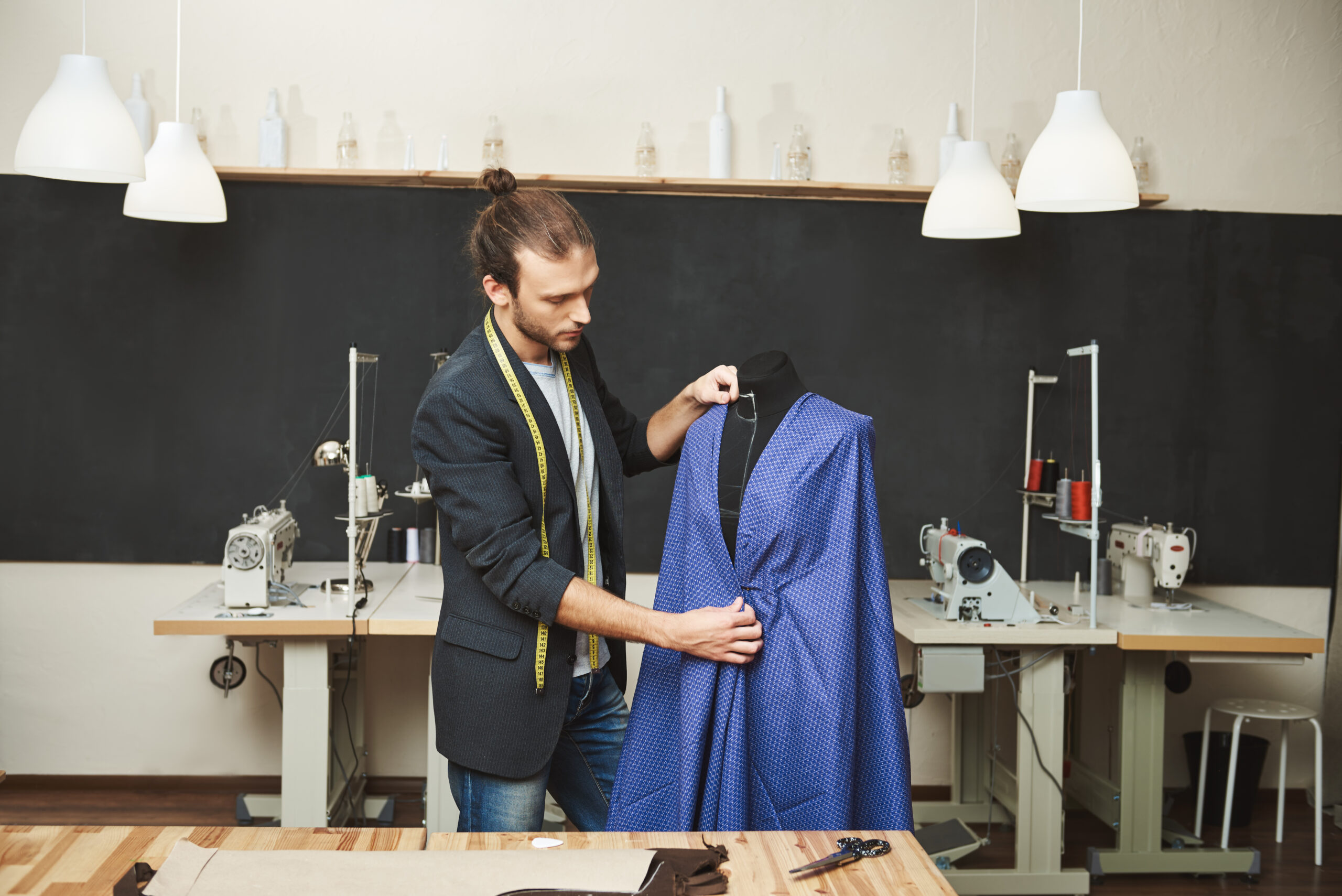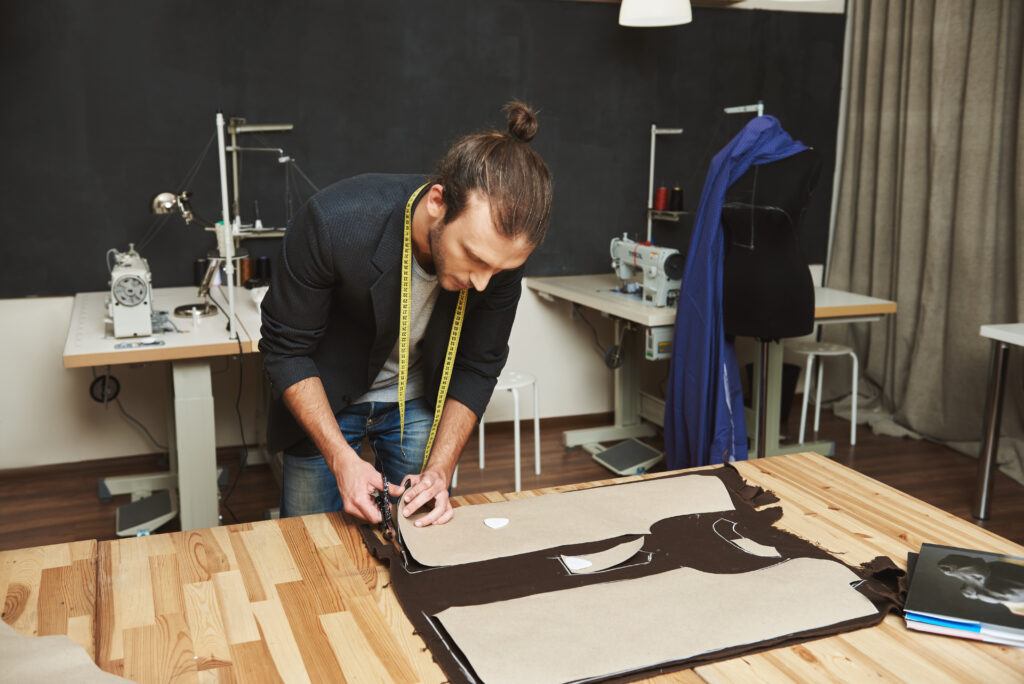
Young shaved good-looking caucasian male fashion designer in stylish outfit working on new blue dress for spring collection in his workshop. Artist creating beautiful clothes in his workshop.
Have you ever wondered why some stitches hold material so well while others add looks or structure? The answer lies in understanding Nahttypen—the German term for “types of seams.” These hems are better than simple methods to join material; they define strength, flexibility, and build. Every sewing project, from clothing to upholstery, depends on picking the right seam. Beginners often struggle with choosing the right Nahttypen, leading to weak or bulky seams. Understanding how per type works can enhance your craft dramatically. Let’s explore the essential Nahttypen and when to use them.

1. Simple Seam (Geradstich-Naht)
This is the most basic and widely used seam in sewing. It joins two pieces of fabric by sewing a straight line and is usually pressed open. Seen in everything from shirts to bedsheets, it’s ideal for non-stretch fabrics. It’s straightforward to stitch and functions nicely when strength isn’t the top priority. Newbies love it because it helps them get used to sewing in successive lines. Although easy, if not sewn correctly, it can unravel or weaken quickly. Supporting the ends with backstitching causes it to last longer.
Checklist: Simple Seam
- ✅ Great for beginners
- ✅ Use on cotton or woven fabrics
- ✅ Hem size: 2.5 mm
- ✅ Always press the seam open
- ✅ Reinforce with backstitching
- ✅ Not ideal for stretchy fabric
- ✅ Watch for fraying edges
2. Double-Stitched Seam (Doppelt genähte Naht)
This stitching style offers more power than an easy seam. It’s usually used in pants, pants, and loads where extra durability is needed. This seam can also support material layers lying balanced and tidy. Though it brings a bit more extended stitch, it’s ideal for serious or dense fabrics. It gives your project a neat inside finish without needing a serger. The seam is usually pushed to one side for added stability. Even though it’s healthy, trimming the seam before the double stitch is essential for a tidy look.
Checklist: Double-Stitched Seam
- ✅ Use for strength and durability
- ✅ Plan for pants, jackets, or bags
- ✅ Stitch one seam, trim, then sew too
- ✅ Great for thick or layered fabrics
- ✅ Press the seam to one side
- ✅ Enhances project neatness
- ✅ Best for stress-prone areas
3. French Seam (Französische Naht)
The French seam has raw edges, making the interior of the attire look clean. It’s notable in light materials like silk, chiffon, or organza. This stitching is sewn twice—first with the wrong flanks together, then with the right flanks. Though it brings more momentum, the result is experienced and smart. It prevents fraying and gives garments a durable finish. It’s especially useful for see-through fabrics where raw edges would show. However, it’s not ideal for very thick fabrics due to material bulk.
Checklist: French Seam
- ✅ Sew delicate or see-through fabrics
- ✅ Encloses raw edges completely
- ✅ Creates a clean and finished interior
- ✅ Use short stitch lengths
- ✅ Takes extra time, but worth it
4. Flat-Felled Seam (Kappnaht—Strongest Nahttypen)
Flat-felled seams are one of the strongest Nahttypen and are commonly used in denim jeans. This hem tucks the material and has raw edges before topstitching. It examines pure from both inside and outside, making it ideal for visible seams. Because it seals the fabric tightly, it handles stress and frequent washing very well. It’s a great option when both building and strength issues are present. It requires careful measuring and stitching but pays off in durability. Often found in sportswear and uniforms for this reason.
Checklist: Flat-Felled Seam
- ✅ Extremely strong and long-lasting
- ✅ Best for jeans and sportswear
- ✅ No need for serging edges
- ✅ Looks clean on both sides
- ✅ Needs precise folding
- ✅ Ideal for heavy-duty use
- ✅ Prevents fraying completely

5. Overlocked Seam (Versäuberungsnaht mit Overlock)
An overlocked seam uses a special machine to trim and wrap thread around fabric edges. It’s fast, neat, and widely used in mass garment production. Ideal for stretch fabrics like knits, it allows fabric to flex without breaking threads. While it doesn’t look as shiny as French or flat-felled hems, it holds a lot of period. This stitching is great for T-shirts, leggings, and loungewear. It reduces bulk and makes clothing lighter. However, you need an overlocker machine to make this seam properly.
Checklist: Overlocked Seam
- ✅ Great for stretchy fabrics
- ✅ Used in ready-made clothing
- ✅ Needs an overlocker (serger)
- ✅ Allows fabric to stretch
- ✅ Trims and sews in one go
- ✅ Not very decorative
- ✅ Best for casual wear
Conclusion: Choosing the Right Nahttypen Matters
Understanding different Nahttypen helps you sew better and smarter. Each seam has a goal—some offer power, others type or flexibility. Selecting the correct one makes your task last longer and look more professional. Whether you’re stitching a soft blouse or sturdy pants, the stitching can make all the difference. Mastering these basics will boost your sewing spirit and results. Take your time to try them all and see which one fits your job best. Stylish stitching choices, but time, action, and material.
Final Checklist:
- ✅ Match Nahttypen with fabric type
- ✅ Practice each seam before your project
- ✅ Use the right needle and thread
- ✅ Press seams neatly as you go
- ✅ Don’t rush—quality comes from care
- ✅ Learn machine settings for special seams
- ✅ Always test on scrap fabric first








1 thought on “What Are the Different Nahttypen in Sewing (In 2025)”